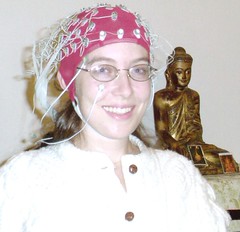
I've changed my mind again, and now I think I will actually post some of my experiences from the autumn retreat at IMS. Let's start at the beginning...
Before the retreat I got an e-mail asking if I'd participate in an experiment designed to measure the physical and mental effects of intensive meditation practice. I do like being a guinea pig--so much more relaxing than analysing the experiments oneself--so of course I said yes.
The experiment is actually a bunch of parts: saliva tests to measure stress levels before, during, and after the retreat--see the physical effect of the practice, and how long it persists in "everyday life"; blood tests before and at 3 and 9 months after, to measure telomere shortening, a measure of aging: since stress hormones increase the rate of telomere shortening, thereby hastening cell death, meditation might decrease the rate and extend the body's lifespan (might--there's no evidence yet, as far as I know, but it does seem reasonable); and EEG experiments to measure the brain's ability to concentrate for long periods of time on boring, repetitive, and even annoying tasks. The EEG part was done at the beginning and end of the retreat; the picture is from the first session, with me looking pale and stressed-out. (I think it's really neat that EEG equipment is compact enough now that it's possible to pack it up in a briefcase and set up an experiment wherever.)
The blood tests ended up being quite entertaining: apparently my veins are small and floppy or easily torn (or something like that) and it's hard to get a needle in securely to get blood out; and when they were taking the needles out the blood level in them would actually go down: my veins were sucking the blood back into my body. "No! My blood! You can't have it!" Greedy veins. They clearly haven't listened to the teachings on generosity, or on non-self for that matter.
The EEG tests were fascinating. One of the tasks involved listening to tones (mostly 500 and 1000 Hz, with the occasional "different" one: 475 or 1050 Hz) and pressing a button whenever one of the "different" ones came along. At the beginning of the retreat, this task was extremely frustrating for me, because 475 and 1050 Hz are almost but not quite semitones away from 500 and 1000 Hz, and also the tones came at almost but not quite rhythmic intervals. By the end of an hour and a half of this my brain was having a temper tantrum. "Don't these people know that's NOT RIGHT?" I came out of the experiment madder than a wet hen. Doing the exact same thing at the end of the retreat was downright enjoyable. I'd just spent 3 months listening to sounds as sounds, and getting into intensely pleasurable altered states of consciousness listening to the rattle of the radiator, so I was able to hear the tones as tones, instead of as musical sounds that weren't correctly musical. Plus, the mind likes to concentrate, and here was a concentration exercise, oh joy! So instead of the test being a boring, taxing, ordeal, it was quite a pleasant interlude.
The experiments are overseen by Dr. Richard "Richie" Davidson, from the University of Wisconsin. He has been meditating himself since the 70s, and when he was just starting out in psychology research wanted to find a way to measure the effects of meditation on the brain; but at that point the tools available were just too primitive. Since the advent of fMRI, however, a lot more has become possible. Several years ago, he received a personal invitation from His Holiness the Dalai Lama to come to Dharamsala to start doing research on Tibetan monks who were experienced meditators. The first trip was only partially successful. They brought over all their equipment, but although all the monks were very gracious about talking about their practice, none of them would consent to participate in experiments. It became clear that this refusal was just because the monks didn't know anything about science. When His Holiness heard about this, his response was to start a program called Science for Monks-- a yearly seminar for Tibetan monks, taught by Western scientists. Richie told us about this program during the talk he gave on one of the last nights of the retreat. When I first heard about it, I started hyperventilating. I had just that day been wondering how to combine my training in physics with something that is of actual benefit to humanity, and presto! here it is. I've sent out some e-mails asking for more information and am still waiting to hear back, but who knows? Maybe in December I'll be in India teaching monks how to do physics.

No comments:
Post a Comment